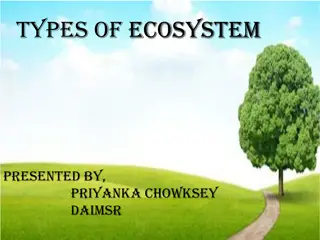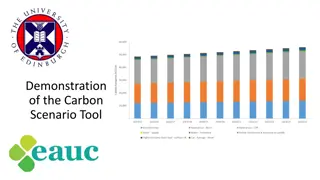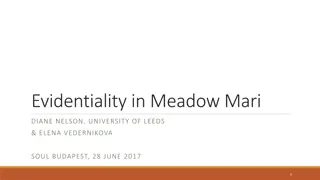Carbon Transformations in Ecosystems: Meadow Simulation Analysis
Explore the patterns observed in a meadow simulation regarding carbon transformations and energy flow within ecosystems. Analyze the changes in organic matter among different populations over 100 years, draw conclusions on population dynamics, and identify unanswered questions for further investigation.
Download Presentation

Please find below an Image/Link to download the presentation.
The content on the website is provided AS IS for your information and personal use only. It may not be sold, licensed, or shared on other websites without obtaining consent from the author. Download presentation by click this link. If you encounter any issues during the download, it is possible that the publisher has removed the file from their server.
E N D
Presentation Transcript
Carbon: Transformations in Matter and Energy Environmental Literacy Project Michigan State University Ecosystems Unit Activity 2.3 Evidence-Based Arguments for the Meadow Simulation 1
Unit map You are here 2
Complete the Evidence-Based Arguments Tool Name: _____________________________________________ Class: _____________________________________________ Date: ______________________ 2.3 Evidence-Based Arguments Tool: What Patterns Did You Observe in the Meadow Simulation? Use your Predictions and Planning Tool and the 2.2 Meadow Simulation Worksheet. Complete this tool with patterns from class evidence, conclusions, and unanswered questions. Your Evidence: What did you find in your own investigation? What was the organic matter in each population after 100 years? Grass ___________ Rabbits ___________ Foxes ___________ Conclusions: What patterns did most groups in the class observe? What happened to the amount of organic matter in each population (circle the best choices)? Grass: Increased Decreased Same Rabbits: Increased Decreased Same Foxes: Increased Decreased Same What was the upper limit on fox organic matter after 100 years? _____________________ How do the initial settings affect what happens to the different populations over time? Unanswered Questions: What do you still need to figure out? Question 1. What happens over 100 years when each population starts with an organic matter mass of 500? 2. What settings lead to the highest fox organic matter after 100 years? What was your largest fox organic matter after 100 years? What initial settings did you use? Grass ___________ Rabbits ___________ Foxes ___________ What initial settings did you use? Grass ___________ Rabbits ___________ Foxes ___________ 3. What settings lead to all the foxes dying? What patterns do you see when all the foxes die? Ecosystems Unit, Activity 2.3 Carbon: Transformations in Matter and Energy 2019 Michigan State University 3
Comparing ideas with a partner Compare your evidence, conclusions, and unanswered questions for each of the Three Questions. How are they alike? How are they different? Consider making revisions to your argument based on your conversation with your partner. 4
Question 1: What happens over 100 years when each population starts with an organic matter mass of 500? Evidence Conclusions Unanswered Questions 5
Question 2: What settings lead to the highest fox organic matter after 100 years? Evidence Conclusions Unanswered Questions 6
Question 3: What settings lead to all the foxes dying? Evidence Conclusions Unanswered Questions 7
Conclusion #1: The Organic Matter Pyramid The organic matter diagram that shows the maximum fox and rabbit mass in the Meadow Simulation resembles a pyramid. 8
Conclusion #2: When Foxes All Die Only three final organic matter diagrams are possible in the meadow ecosystem. Foxes are more likely to die out than rabbits or grass. 9
Discussion Questions What are the processes that lead to the organic matter pyramid? Why are foxes more likely to die out than rabbits or grass? 10























